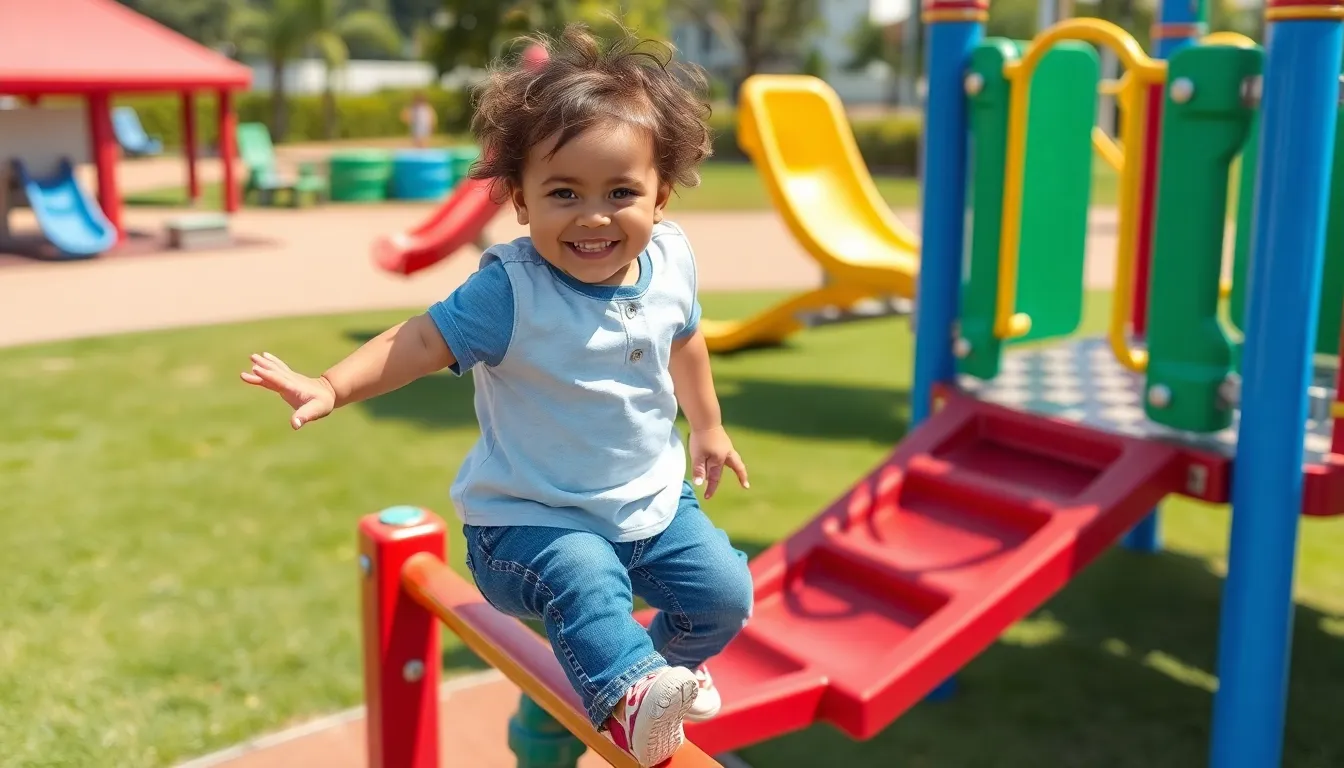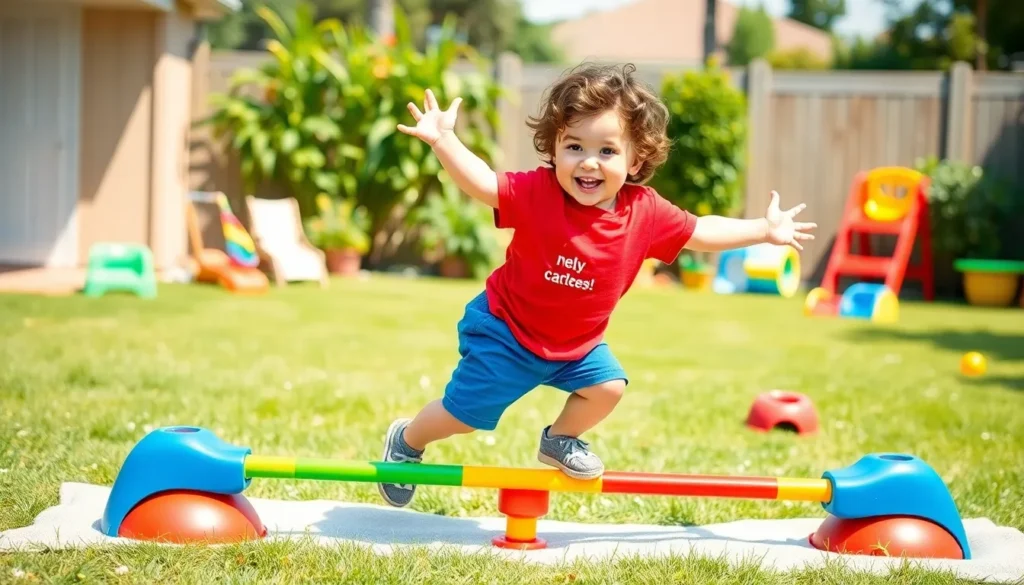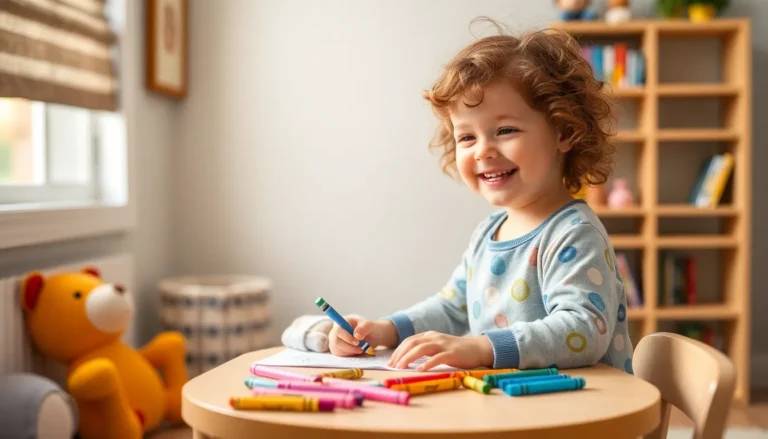Table of Contents
ToggleWatching a toddler attempt to balance is like witnessing a tiny circus act—wobbly legs, arms flailing, and that look of sheer determination on their little faces. It’s a delightful chaos that not only entertains but also plays a crucial role in their development. As they navigate the world, mastering balance is key to building confidence and coordination.
Understanding Toddler Balance
Balance refers to the ability to maintain stability while in motion or at rest. It involves coordination and control of the body’s movements, allowing toddlers to navigate their environments safely.
Definition of Balance
Balance encompasses the body’s ability to stay upright and oriented. It relies on sensory systems, muscle strength, and neural coordination. Toddlers develop balance through activities like walking, running, and playing. Engaging with surfaces of different textures and inclines enhances their proprioceptive feedback. When children learn to balance, they utilize their inner ear for spatial awareness, muscle strength for stability, and visual cues for guidance.
Importance of Balance in Toddlers
Balance plays a critical role in a toddler’s physical development. Effective balance contributes to coordination and physical confidence, vital for engaging in various activities. Children benefit from improved gross motor skills, like climbing and jumping, which leads to more interactive play. As toddlers master balance, their ability to interact with peers grows, fostering social skills and encouraging exploration. Each successful movement builds self-esteem, reinforcing their readiness for challenging tasks. Recognizing the significance of balance supports healthier development during these formative years.
Factors Affecting Toddler Balance

Various aspects contribute to a toddler’s ability to maintain balance. These factors include physical development and environmental influences, both playing crucial roles in this learning phase.
Physical Development
Physical growth directly impacts balance. Muscular strength supports stability, helping toddlers control their movements. Development of coordination intertwines with balance as toddlers practice activities like hopping or climbing. Additionally, the maturation of the vestibular system enhances their sense of spatial orientation. As gross motor skills improve, toddlers gain confidence in their ability to move. Participation in activities that promote agility and flexibility also strengthens balance. For instance, dancing or playing on playground equipment can further develop physical capabilities.
Environmental Influences
A toddler’s environment significantly shapes their balance skills. Surfaces they encounter, such as grass, carpet, or uneven ground, offer varied challenges to navigate. Engaging in outdoor exploration provides opportunities to practice balance on various terrains. Availability of supportive equipment, like balance beams or soft mats, encourages safe play and skill enhancement. Social interactions with peers during playtime foster balance development through mimicry and camaraderie. Encouragement from caregivers also strengthens toddlers’ willingness to tackle new challenges, boosting their balance abilities even more.
Activities to Enhance Toddler Balance
Engaging in various activities boosts a toddler’s balance skills significantly. These activities can take place indoors or outdoors, providing different settings for development.
Indoor Activities
Balance beams serve as an excellent tool for indoor balance practice. Parents can easily create a balance beam using tape placed on the floor. Try activities like hopping on one foot or walking backward along the line. Encouraging dance sessions lets toddlers explore movement while enhancing rhythm and stability. Simple games, such as “Simon Says,” can promote agility and responsive balance. Using cushions, setting up obstacle courses offers a fun way to navigate uneven surfaces, which challenges stability. Incorporating these activities into daily routines fosters confidence while improving coordination.
Outdoor Activities
Playing outside introduces various surfaces and environments to explore. Walking on grassy areas or sandy beaches encourages toddlers to adapt to different textures. Setting up nature walks involves stepping over small logs and rocks, promoting agility. Riding tricycles or scooters builds leg strength while enhancing balance during movement. Playground equipment like slides and swings invites toddlers to climb and engage in balancing acts. Group activities, such as tag, foster social interaction while practicing quick directional changes. These outdoor challenges help toddlers improve their stability and coordination effectively.
Common Balance Issues in Toddlers
Toddlers may experience various balance issues that affect their coordination and stability during activities. Identifying these signs early helps in addressing any potential developmental concerns.
Signs of Imbalance
Imbalance in toddlers manifests in several observable ways. Frequent stumbling or falling may indicate difficulties with maintaining stability. Hesitance to walk on uneven surfaces can signal uncertainty in balancing skills. Parents might notice that toddlers overly rely on furniture for support or avoid climbing when encountering stairs or playground equipment. Additionally, a lack of coordination during play, such as difficulty catching or throwing a ball, suggests balance challenges. Awareness of these signs can prompt timely intervention and support.
When to Consult a Professional
Consulting a professional becomes essential when a toddler displays consistent symptoms of imbalance. Persistent falling or an inability to maintain balance during simple activities warrants evaluation. If a parent observes that the child avoids physical play or becomes overly fearful of moving, seeking advice is critical. Irregularities in muscle tone or strength may indicate underlying issues that require attention. Early assessments by a pediatrician or physical therapist can provide valuable insights and appropriate guidance for improvement.
Toddler balance is a vital component of their overall development. As they navigate through various activities and environments, they build confidence and coordination. Encouraging exploration and play not only enhances their physical skills but also fosters social interactions that are crucial for their growth.
Caregivers play an essential role in supporting toddlers as they face new challenges. By providing a safe and stimulating environment, they can help nurture balance skills effectively. Recognizing early signs of imbalance ensures that any potential issues are addressed promptly, paving the way for a healthier developmental journey. With the right guidance and opportunities, toddlers can thrive as they master the art of balance.







